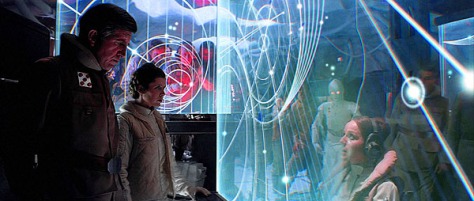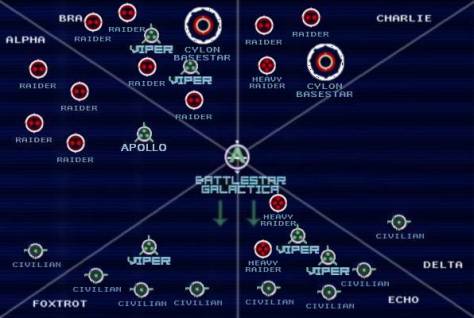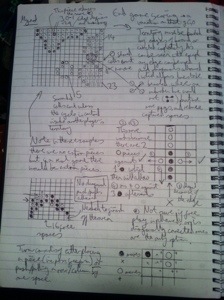 Chimera CCG (the CCG doesn’t just stand for Collectible Card Game, but Comics, Collectibles and Games) is situated in Beeston in Nottingham, near the University. Originally sited at Ripley, before expanding to Beeston, Chimera’s owners, Andy and Heather Leach, eventually relocated “lock stock and ammo crate” to the current location, due to a more friendly environment, more affordable rates and a better ability to support its local community; including much more accessible free parking. Although it isn’t a typical “footfall” location, Andy confirmed, you have to seek Chimera out rather than accidentally discover it, as would occur if they were in a more central city location. The joy is that people do. Seek it out that is. Chimera has a loyal and growing community of players and customers, which I must confess (in the interests of transparency) includes my nephew, who introduced me to the store during a recent family visit.
Chimera CCG (the CCG doesn’t just stand for Collectible Card Game, but Comics, Collectibles and Games) is situated in Beeston in Nottingham, near the University. Originally sited at Ripley, before expanding to Beeston, Chimera’s owners, Andy and Heather Leach, eventually relocated “lock stock and ammo crate” to the current location, due to a more friendly environment, more affordable rates and a better ability to support its local community; including much more accessible free parking. Although it isn’t a typical “footfall” location, Andy confirmed, you have to seek Chimera out rather than accidentally discover it, as would occur if they were in a more central city location. The joy is that people do. Seek it out that is. Chimera has a loyal and growing community of players and customers, which I must confess (in the interests of transparency) includes my nephew, who introduced me to the store during a recent family visit.
 On visiting the shop, one of the players I walked in with announces that it has changed a lot since last time she was in; the playing space and a large part of this quite spacious shop are reconfigurable, with some displays being movable to allow up to 70+ game players to be accommodated easily. Having said that, Chimera also run larger events at nearby locations, including hotels, etc, when greater numbers need to be supported for events. These competitions and tournaments are just an additional part of the service that Chimera provides to deserve it’s fan base. Andy is quite philosophical about the threat of the Internet. A Dork Tower cartoon, decorating the fridge near the counter, says it all. Without active support, the FLGS (Friendly Local Game Store) will never compete. Andy comments on the cartoon, “You get what you (don’t) pay for.”
On visiting the shop, one of the players I walked in with announces that it has changed a lot since last time she was in; the playing space and a large part of this quite spacious shop are reconfigurable, with some displays being movable to allow up to 70+ game players to be accommodated easily. Having said that, Chimera also run larger events at nearby locations, including hotels, etc, when greater numbers need to be supported for events. These competitions and tournaments are just an additional part of the service that Chimera provides to deserve it’s fan base. Andy is quite philosophical about the threat of the Internet. A Dork Tower cartoon, decorating the fridge near the counter, says it all. Without active support, the FLGS (Friendly Local Game Store) will never compete. Andy comments on the cartoon, “You get what you (don’t) pay for.”
Repost from the Fantasy Flight forum Shh, don’t tell anyone, but one of my Games and A.I. students and I are working on a Star Wars Targeting Computer bot to play/suggest moves for X-Wing. We feel that this is both canon – “Luke, you switched off your targeting computer! What’s wrong?” – and we’d like to honour this amazing game by creating an A.I. bot competition in the style of Robocode http://robocode.sourceforge.net/ http://en.wikipedia.org/wiki/Robocode by providing a testbed to allow bots to play in the X-Wing Universe. We hope that making a computer version of the board game, as the first step towards opening this up for artificial intelligence would be both acceptable and of interest to Fantasy Flight and the X-Wing community. If we get far enough along, we hope to “enter” our own attempt at a bot in the UK X-Wing Championships to be hosted at the UK Games Expo, assuming that this would be allowed. Here is a timeline of what we hope to develop, all of which (possibly apart from the A.I. module itself) will be open source: 1) Visualisation of pieces and board state, movements, etc, in the style of theStar wars tactical displays: with inspiration from the following: and the more recent Battlestar Galactica tabletop tactical displays: The aim here to provide the ability for tournaments to have an abstract projected top down display of the game at hand with some automation in moving ships on screen to match the current board state. We would need some “nudging” to be able to make sure the display matched the board; e.g. If the ref says the X-Wing can attach the TIE, but the computer’s (never inaccurate) digital movement says no, then the physical game would have to take priority. Think Vassal module, but customised to enable the later stages. Clearly, at this stage the intent is to provide a way for a computer program to have access to a relatively accurate board position for ships, and have encoded their ability to move, etc. Fantasy Flight, I am hopeful that if you allow the Vassal mod then this is acceptable. 2) Automation of the movement and action phases of each ship type, subject to the previous “nudging”, including a representation of ship and pilot capabilities and game related stats to enable them to be represented on the display; e.g. TIE 3 has Focus, TIE chose Evade, Y-Wing has sustained 2 shield damage. Clearly, the Vassal mod has attempted to not breach copyright, and we would want to avoid similar infringements, but we would need to be able to simulate the complete state of the game, including pilot stats, in order to allow a bot half a chance to be able to “play” in the proper environment. 3) Library functions to fully automate a game of X-Wing in emulation, so that A.I. (that is Tactical Computer) bots – or should I call them ‘droids? – can play simulated games. Many artificial intelligence techniques require sped up automated games in order to evolve suitable strategies of play. 4) An A.I. of our own to test the testbed, which we would then play against humans to see how well it would perform. This bit, I think, we’d need to keep closed source. In the event that we actually get to (4), an ambitious and ridiculous dream, then Fantasy Flight would have to rule on whether bots would be allowed in tournaments. I’m hoping, at least as a special occasion, this might be allowed, if not in a regular competition. 5) Requesting from Fantasy Flight a bespoke ‘droid pilot card to be allowed official recognition. For example, a tactical computer, no matter how well programmed should (in the spirit of the franchise) not have Focus as an option, but should be very cheap (if not free) to buy; working on the assumption that the human player fielding it MUST abide by the program’s choices in battle for the ships controlled by it. The skill then comes in how well you have actually programmed your Tactical Computers. It would be assumed that TCs would be ship specific – hence the need for unique pilot cards for each ship type – but that the basic stats would be those of the ship’s reference card. The rating of the pilot would need FF to decide, but (for example) a bot would be very fast to react, but slow to target, which would suggest a low rating. Other balance issues, should the idea of a TC be one that FF like as an extension to the rules (even without a “real” A.I. playing, but rather a human pretending), might be extra evades, better target locks, etc, at the expense of the loss of focus. Of course, (5) is pure speculation, but fun to consider. I thoroughly expect any bot to be much, much worse than an average human. However, the idea is one that (despite probably meaning a lot of work) really interests me. Please do comment, to tell me what you think. Would you be willing/scared to play against a ‘droid (” We don’t serve their kind here! … Your droids. They’ll have to wait outside.”) or should they never be allowed to play in tournaments? One alternative to a low rating could be an average (middle range) or user selectable pilot rating, which would allow the programmer to decide between move first shoot last and move last shoot first strategies. Some more reference images (DRADIS from Battlestar Galactica): Clearly, we would be looking to get one of the art students to do a suitably Star Wars styled representation of the X-Wing ships, but you can see how a Viper (above) is similar to an A-Wing. This is to provide a “mood board” for conceptualising what the display would look like. DoctorMike “TIE Automated Starfighter (TIE Droid Starfighter) produced by World Devastators in the comic mini-series Dark Empire I.” http://boardgamegeek.com/thread/925607/tie-automated-starfighter Cardiff is an outstanding place to be a gamer. Although it isn’t home to any major gaming events in the die hard calendar (yet!), it hosts two exceptional games shops, both of which provide the kind of service that should shame you, if you live or work nearby and persist in purchasing your games from Amazon. While normally there is a cellar for game play, with regular events for diverse games, currently the playing space is relocated due to seasonal flooding. However, RoP also run two game events a month: I’ll cover their events in more detail in coming months, but it is safe to say that the staff are both knowledgeable and accessible to both novice and expert alike. The @Boardroomers February Game Design Competition deadline is TODAY! Here is my entryKipling the Seemingly Saying Something Game, which will also be my first February entry for #1GAM; I originally developed three @Boardroomers games, but (understandably) they decided to only allow one submission per designer. The other two games: will be posted later this month. I came across this site that automates making Hitler Downfall parodies so decided to have a go. It’s not quite straightforward to know what to put in each box, as the transcript doesn’t quite match up to the one at the Hitler Downfall Parody Wiki (?). So here attached is an eXcel script hitler-downfall-script1 to help you. Here’s my meta effort to thank Jacek Fedoryński for making this possible. Update My first submission (actually two!) for #1GAM “Get thee behind me…” GTBM rules “Get thee behind me…” and “Mynd” (part 1 above) and “Mynd” (part 2 below) – notes from my #1GAM project book “Mynd” This was an attempt at making a “classic abstract” game using a existing board and pieces (in this case, GO and, for the record, “mynd” is Welsh for “go”), rather like Arimaa did with Chess. Also fortuitous was picking up a super cheap, mint copy of Pegity in a charity shop yesterday for £3, which gave me some lovely wooden peg pieces (~200 in four colours 🙂 with a cheap thin card board 🙁 but nothing’s perfect). So, my plan to use Tiddlywinks and a GO board was not needed. Of note, however, is the 16×16 board, rather than 19×19, which is more akin to The Viking Game that has 8×8, 11×11 and larger variants. Basically, the larger the board, the longer and more complex the game, so 11×11 will be best suited to learning the basic tactics, but 16×16 or 19×19 will offer more opportunities. The number of required counters of each colour will depend on the size of the board, but a rule of thumb would be the total number of all the coloured counters should be about two thirds the size of the board – 20 for each player for 11×11, 43 for 16×16, 60 for 19×19. NOTE: These may need adjusting after playtesting. GO has 181 black and 180 White counters, which is sufficient to cover the whole board, even though it is unlikely that players would do so. Mynd rules Depending on whether 2, 3 or 4 players are playing, each player starts with one coloured peg in the corner (or, for one of 3 players, the opposite edge) of the board (see sketch above). After that play consists of one of four actions: The first case allows players to use pieces to grow into new territory or reduce the final score for opponents. The second case is for growing or adding to the defence of their boundary markers, but also allows for a single piece to be slid along a row or column. In the third case, pushing the pieces along a row may upset the balance of connected columns. However, a row/column may not be pushed in a direction where a piece would be pushed off the board; so edges and corners are particularly useful. Finally, the fourth case is for scoring, the area contained by counting unoccupied spaces inside a completed boundary, excluding pieces of other players, will contribute to the final score. Play continues until players agree there are no moves left that do not result in a cycle of play that results in a board position being repeated. Alternatively, play can stop upon agreement by the players. Then the unoccupied area of each player is calculated. Areas surrounded by one player’s counters, if subsequently surrounded by those of another, will not count towards either player scores. Please leave feedback on Mynd in the comments below, or over at http://onegameamonth.com/ Journal First Entries. A “loose” set of rules to follow: Clearly, #1 and #10 are the most important. To paraphrase Debbie Allen: “You got big dreams. You want As you can see, I’ve already got 12 loose ideas, but it’s not written in stone. It’s likely some will fall by the wayside or other concepts will present shinier alternatives. However, these are the real things I would be upset not to achieve: “One board/card game taken up by publisher, one game book in Kindle Store, one mobile game in AppStore, enough revenue to pay licences, one person saying something was exceptional. Oh, and World Peace!” — from http://www.onegameamonth.com/DoctorMikeReddy This post will serve two purposes: If this book cover means nothing to you, you are either quite young or very old. It’s by Russ Nicholson and two other guys… I came across this book in a dusty cupboard that was the Puffin/Penguin book “club”; a sponsored form of school shop that supplied the publisher’s current titles in a ‘sale or return’ arrangement. I’d made many discoveries during the lunch hours Mr. Allen, my first year form teacher and later close friend, gave up running the shop. I think I may have been its only customer in fact. Anyway, he would recommend things he thought I, a voracious reader who had read about 3/4 of the school library by that point, would be interested in. Warlock was a welcome relief from early O-Level revision, as it was waiting for me at the start of the fifth form school year (September 1982). It didn’t do too much harm to my work, thankfully, as I got 5 As 2 Bs a C and a D, but I did ironically fail English, and had to retake that a year later in Sixth Form. [Kids, O-Levels are not, as you imagine like the Harry Potter OWLs of J.K. Rowling creation, but just like GCSEs really, except you did ALL your assessments in one go – no continuous assessment or coursework! – in a thing called… an exam… while imprisoned in a dusty hall under the watchful eyes of scowling teachers, who’d much rather be drinking tea (or in one case beer or gin) in the lurking smoke-filled staff room. So, actually quite like OWLs, thinking about it…] For those of us who remember the horrors of Thatcher’s Britain, Miner’s Strikes and the promotion of self-interest over social duty, it may come as a relief to know that Many current game designers and writers owe a lot to the green-spined wonders that opened up the idea of non-linear narrative and interactive story telling. Ok, Livingstone and Jackson weren’t the first – there are examples before their first title (shown above), “The Warlock of Firetop Mountain”. Notably Tunnels and Trolls “solo adventures” as well as others – but they stuck somehow. Maybe it was the unique UK writing style, but other brands don’t have the same nostalgia or affectionate appeal as Fighting Fantasy. Not to say that “Choose you own Adventure”, “Decide your Destiny” and a range of other brands haven’t innovated or done some things better, and (hopefully) Green will cover these, if only to contrast with the FF books as they still compare favourably, in my opinion. However, it is (I believe) timely and topical to consider an official history of this form of literature, especially as tablet computers (iPads, etc) are bringing about something of a resurgence. You can find out more by clicking the banner below, or Jonathan’s FaceBook Page. MaZone – A #1GAM #onegameamonth project So, as part of #1GAM #onegameamonth (See OneGameAMonth for details), I’m planning a multi-player game book that attempt to innovate on the current formula in several respects: To show MY support for the KickStarter above, I have promised to make the beta of MaZone (a play on Maze and Zone) available for FREE to backers of Jonathan’s book. I am not planning for this to be January’s OneGameAMonth offering, as I am a bit tight for time this month. However, it will be out before Mr. Green’s book is released. I’m sure it will be rough and needing ‘fixing’, and it might just not work or be fun to play/read. However, I am looking forward to trying out something genuinely new in game book design. Fingers crossed. Now turn to Page 1…Javin – Java Battle of Yavin Tactical Computer
Update
Got another canon precedent:Why Cardiff is an excellent place to be a Gamer
Rules of Play
Rules of Play (RoP) is an unassuming little shop in the Castle Arcade in Cardiff. One of those places it might be easy to miss, among the fashionable cafes and weird boutiques.

However, it is not cluttered, and actually quite inviting. There are none of the intimidating tables with sweaty young men hunched over bizarre dioramas, a la Games Workshop. What there is are staff who are keen to please, able to recommend games to meet the needs of Grand Ma wanting a game for her relatives, and the hardened MTG and CCG nut alike. Quite an achievement, and RoP is probably one of the best games shops I have ever frequented.
Firestorm Games
Firestorm Games (aka StormFire) are less easy to come across, being the “wrong” side of the tracks, if only a convenient walk from Cardiff Central Train Station.

The shop itself, is about the same size as RoP, but in two smaller sections; one being predominantly Games Workshop (GW) products, the other being a range of board games and accessories for War Games, etc. It’s quite compact, but nice to see things on display for a company that does most of its selling through the Internet. However, the real jewel in Firestorm’s Tardis-like interior is the fully licensed (!) massive play space, affectionately known as “The Battlefields”. Click the panoramic image below to fully grasp this!


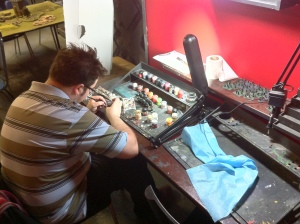
The staff charge a fixed fee for access to the Battlefields (currently a one off £3.60, but periodic membership is also available), but when I attended recently, there were a range of games on hand, as well as those brought by the regulars, and there was an atmosphere of “Let’s make sure everyone gets a game!” from the staff, who could be seen arranging groups of players to guarantee that people wouldn’t have to wait to be entertained. Even I got roped into a quick game of
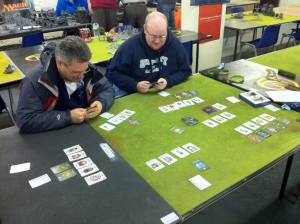
“Evil Baby Orphanage” despite not intending to stay for long. It just reinforced the great atmosphere that Firestorm provides for the young adult gamer. While I don’t think that this store is as accommodating for families – the licensed bar on the premises necessitates some control over who can play on site – it is good to know that the two shops complement each other perfectly. Both Rules of Play and Firestorm are worth a visit, if you are ever in the Welsh capitol. Next time, I will cover RoP in more detail, especially the regular Sunday and Monday events, but in the mean time, here are some other shots from Firestorm’s Battlefields:













Kipling, the Seemingly Saying Something Game – #1GAM Entry for @Boardroomers
Hitler finds out about Jacek Fedoryński
Two #1GAM board games – “Mynd” and “Get thee behind me…”
You can now play GTBM online at Taebl but you will need a copy of the GTBM.taebl file. Note this needs Silverlight, and humans will need to moderate the rules.
I intend to computerise the games at some point, but haven’t locked down a decent A.I. algorithm yet, good enough for solo play/learning. You will need a checkers/draughts/chess/othello/reversi board and pieces for “Get thee behind me…” (or GTBM for short), and a GO board or one of The Viking Game variants for “Mynd”. Coloured counters and a drawn paper board will also work; I got 1000 tiddlywinks in 5 colours for £6 off eBay from SuppliesForAll.
Credit is due to former games students, Matt and Dave, for inspiring this mechanic several years ago.
Each player starts with 8 pieces (white or black) on the nearest row of an 8×8 square board. (Optionally, 16 pieces of each colour on a 16×16 sized board is possible.) Black starts.

GTBM Starting set up
Pieces can be moved diagonally forward left or right or straight back.

The bottom left Black piece cannot move forward right or to the rear.
If a diagonal move gets a piece behind an opponent’s piece – i.e. between the piece and its owner – that piece is removed. Taking is not allowed when moving straight backwards (no backstabbing!).

Blue take is legal, but Red isn’t because that piece was not moving from the side.
The game ends when a player cannot make a legal move; if the other player can move they win, but if there is no legitimate move it is a draw. Alternatively, if all a player’s pieces are captured, and the opponent still has a legal move afterwards, then this too is a victory.
One obvious strategy is to build columns of pieces, as these cannot be taken easily. However, the “two steps forward, one back” philosophy may be useful. Below is an example of attrition, where Black is almost certainly going to lose a piece, because White has a partial vertical line protecting the threatened piece.
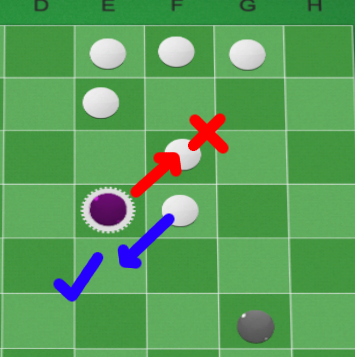
Black cannot take, but White can
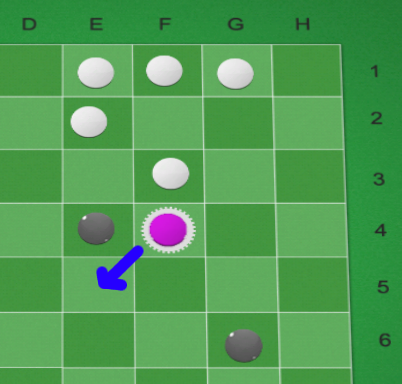
Nothing can prevent Black from being taken, but there is an option to enact tit-for-tat

Defensive play to ensure take and retake
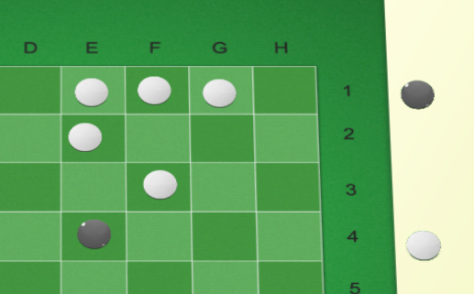
Swap of pieces complete
Please leave feedback on GTBM in the comments below, or over at http://onegameamonth.com/

#1GAM Journal First Entries

fgame ? Well, fgame costs. And right here is where you start paying … in sweatcode” — Lydia GrantYou are the Hero: KickStarter Support and a #1GAM announcement
Jonathan Green, who wrote some of these “Fighting Fantasy” books in their heyday, is attempting to celebrate their 30 year legacy.

When I talked to Ian Livingstone at DragonMeet last month, I asked him if there was any scope for evolution in the game book design. His response was that electronic forms of interactive fiction were probably the best arena for future innovations. I respectfully disagreed at the time, and vowed to try to come up with something that could work in print – still the cheapest and most robust form of distribution – that even he would consider truly revolutionary (or at least different enough to warrant recognition as progress).
“Eh? Phew!” – A #OneGameAMonth Game
Protected: #dmzee – a Twitter Game for Dragonmeet 2012 THE AUTHORITY
